We Uncork Ford's Mustang GT4 and GT GTLM Racers on VIR
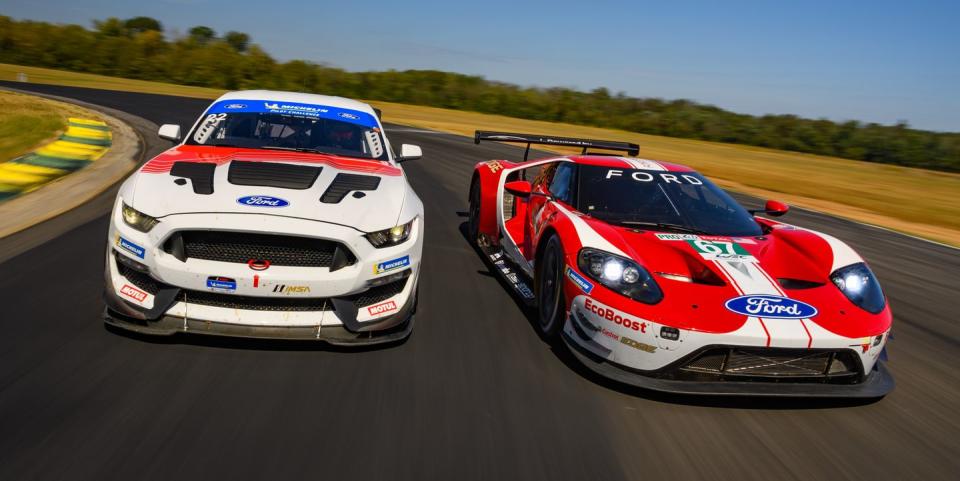
The Ford Mustang GT4 is the appetizer. It's a heavy app for sure, a plate of bacon-wrapped scallops or bison sliders, more than enough all on its own. But today, at Virginia International Raceway, Ford Performance and Multimatic brought more than one trailer. The one that disgorges the Mustang is a triple-axle enclosed deal, fancy but standard fare, goosenecked to a mighty F-series Super Duty pickup. But over in pit lane, there's something a bit more substantial. It's a Ford Performance 18-wheeler for transporting the real primo stuff: Ford's IMSA GT GTLM cars. Next to it, sitting proud on its integral air jacks, is # 67, the just-retired Ford GT Chip Ganassi racing car. Yesterday, I drove a digital facsimile of this car in Ford Racing's simulator. I crashed a lot. Today I'll drive the real thing. This time, there's no reset button.
I drove the Mustang in the simulator, too, although not for as many laps. The Ford people admit that the Mustang sim, despite its authenticity—you're sitting in an actual Mustang interior, rocking to and from on hydraulic rams with the wraparound screen filling the windshield and side windows—isn't quite as dialed in as the GTLM sim. Which means that, in my case, taking it to the limit meant driving as far as I could without decorating the simulator with breakfast. The world's most elaborate racing game elicits a sense of the uncanny valley, and if your eyes are fooled, your inner ear is not.
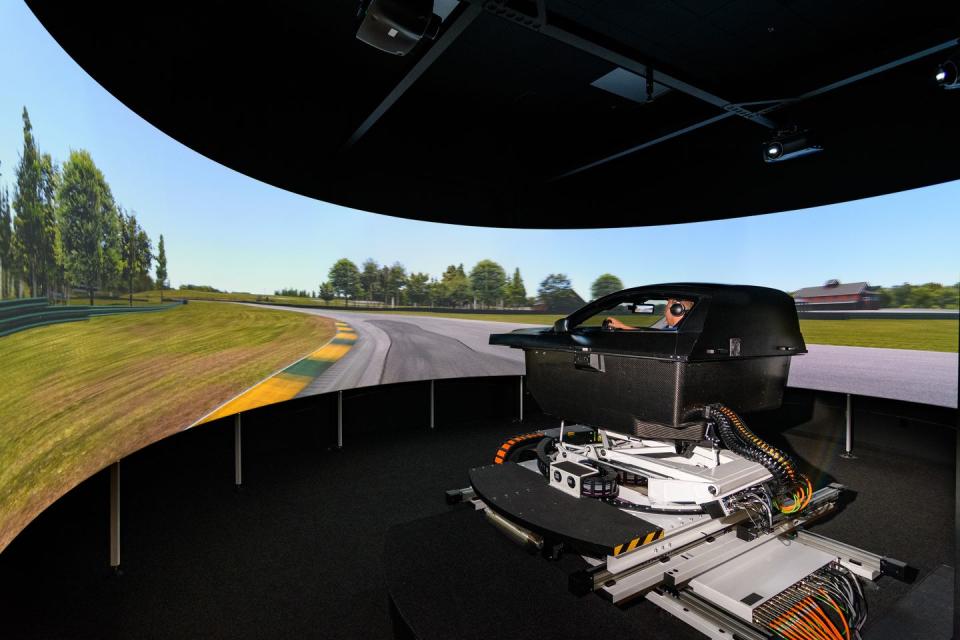
Analog vs. Digital
No such problems with the real thing, though. The GT4's Holinger six-speed sequential manual transmission engages first gear with a muted clack, its pneumatic actuation sending a shiver up through the quick-release steering wheel. Today the sensory feedback is real, and it's delicious.
The GT4 is based on the Shelby GT350R-C race car and uses the Voodoo 5.2-liter V-8, minus that engine's signature piece of hardware, the flat-plane crank. Since IMSA's Balance of Performance dictates that the Mustang GT4 should make around 450 horsepower, there's no advantage in giving its engine a high-winding redline made possible by a flat crank. So, yes, your stock GT350 makes more horsepower than the GT4. No, it is not quicker on any track in this universe.
At a rulebook-minimum 3406 pounds, the GT4 is some 250 pounds lighter than a Shelby GT350. Most of its body is carbon fiber, and the interior is gutted and caged. And this sucker has serious aero. Ford is secretive about actual downforce numbers, but that Dreamliner-sized rear wing isn't there to show off at Race Wars. There's also a front splitter, hood vents, and a rear diffuser—basically, your Viper ACR tricks applied to a Mustang. Speaking of righteous street-legal track cars, the GT4 also uses Multimatic's spool-valve dampers. Pour some out for the Camaro Z/28.
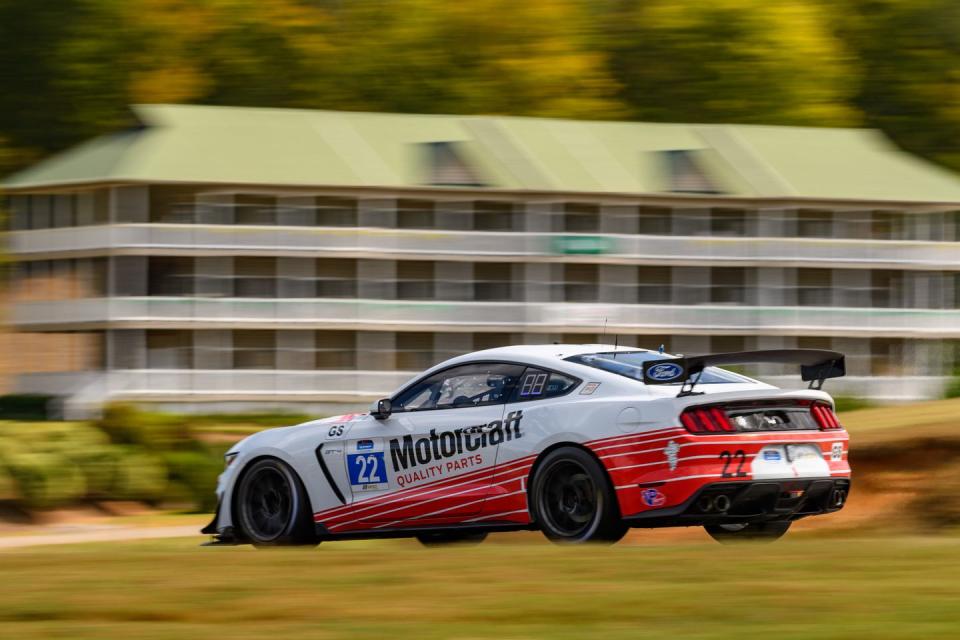
Standing on the deck above VIR's concession stand, I watch racer Andy Pilgrim wrangle the GT4 through Turn 1, a right-hander that is basically a half-trip around a skidpad. And, damn, if it doesn't look like he's drifting it. I can see the slip angle from a thousand feet away. When he pits, I ask him if he was screwing around in Turn 1, seeing how it would stick with the tail out. "Oh, no," he replies. "It just kind of does that." It just kind of does that? Last time I saw a Mustang with its tail out that far, it was on YouTube, "Cars and Coffee Mega-Fails 18."
Soon it's my turn to strap in and try my luck with the GT4's twin-plate racing clutch. With a clear view down the blend line, I give it plenty of revs and get away without stalling. And then, that's it for the clutch. Once you're moving, you shift between the gearbox's straight-cut gears with the paddles alone. The soundtrack is uniquely savage: The conventional cross-plane crank and booming exhaust say NASCAR, but the high-pitched gear whine and instant, perfect rev-matched downshifts speak to exotic road-course machines.
Which is what this is, actually. That much is clear by the end of a lap. The surprise, for me, is that this gutted, winged, malevolent-sounding machine is so friendly, so docile at the limit. In Turn 1, where you're adding throttle and gaining speed for a good long while, I feel the rear end take a set slightly outside the line scribed by the front tires, like the car wants to help tighten your line, thus encouraging more throttle, more speed. The back end is a little bit out, but it doesn't feel like it's breakdancing on a tightrope the way a regular production Mustang would right now. Like Pilgrim said, it just kind of does that.
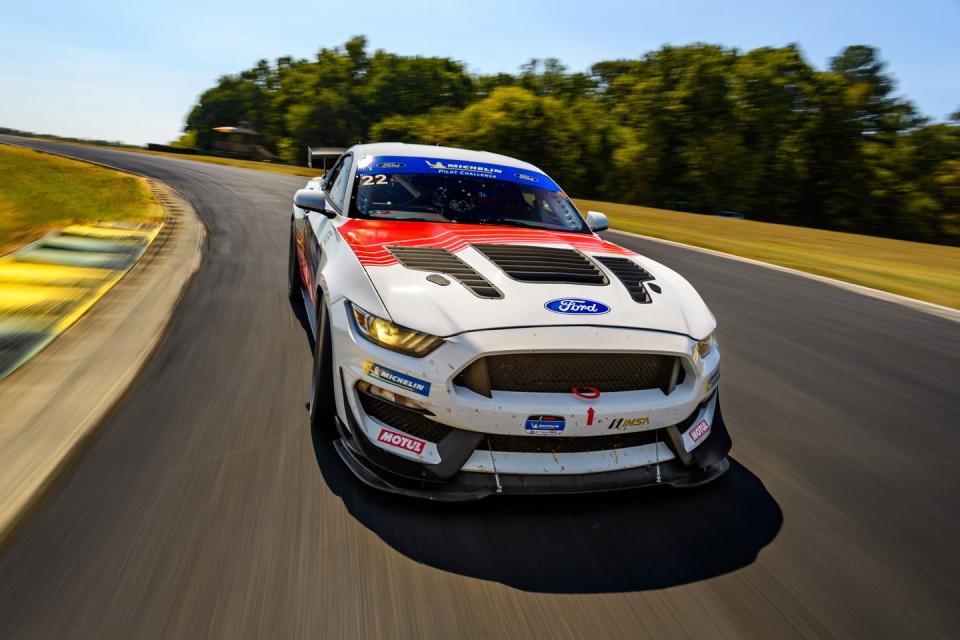
And the downforce, whatever the figure might be, is formidable. On my first few trips through the Climbing Esses—where the straightest line runs across two rumble strips—I don't run too far onto the curbing, mindful of the suspension's stiffness. But as I cheat a little higher on each lap, I find that downforce changes the game at this part of the track. There's undoubtedly a moment of daylight under the inside tires as I skip over the first curb, but then the downforce crushes the car back down onto the track, gravity on steroids. The dampers shrug it all off, too. Big hits are no big deal. Strange that a race car would put me in mind of a Chevrolet Colorado ZR2, but there we have it. If you like the sound of this, Multimatic will sell you a Mustang GT4 for $225,000.
Getting Serious
On any normal day (or week or fortnight), cadging laps in the GT4 car would be the high point of your on-track experience. But today it's the prelude to something even better. Because parked right behind it in the pits is #67. This car's last race was last summer at the 24 Hours of Le Mans, where it finished fourth in the LMGTE Pro class. As in 1968, Ford is getting out of the Le Mans business, so we won't get to see this car battle the new C8.R Corvettes. Which is a shame for race fans but great for me, since it means that I'll get a chance to sample a current competitive GTLM car on a six-lap tour of VIR before it gets locked in a museum or turned into an oligarch's plaything.
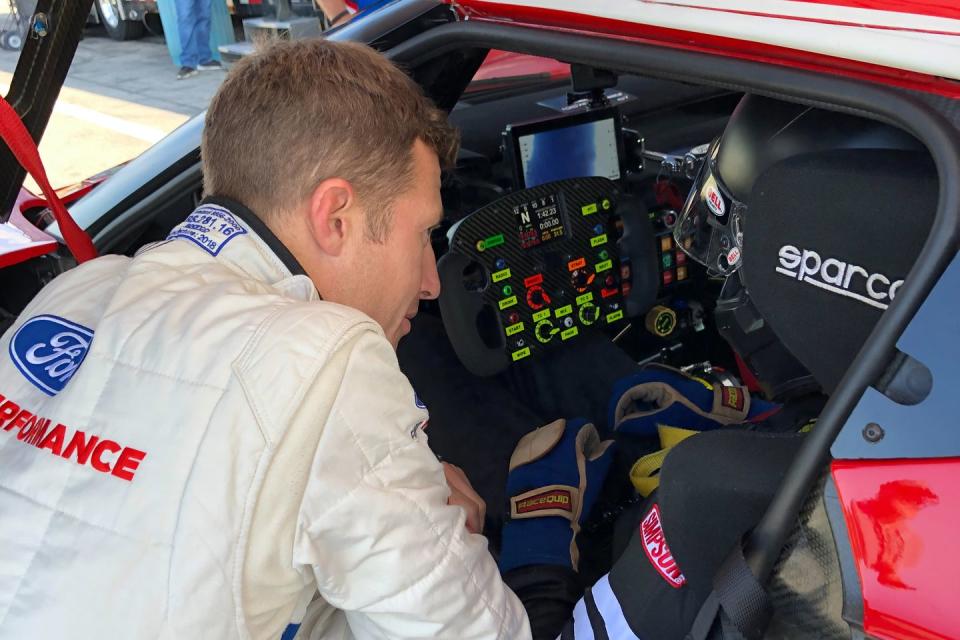
As with the Mustang, Balance of Performance rules mean that the GTLM race car makes less horsepower than the Ford GT production car—by a wide margin. While the street-legal GT makes 647 horsepower and the track-only Mark II makes more than 700, the race car produces between 490 and 520 horsepower, depending on the track. But that's against a minimum weight of only 2822 pounds in IMSA trim. And then there's the override knob.
As I cinch down into the GTLM's deep seat, pro racer Ryan Briscoe gives me a brief rundown on the multitude of switches and knobs on the rectangular steering wheel. Two of them are obvious: the start button and the kill switch, which is emblazoned with a festive skull and crossbones. On the left side is a knob that selects different engine maps. Position 11, where it's set, complies with Balance of Performance restrictions. Briscoe leans in and flicks the knob up to 12, then back down. "Going to 12 takes you off the Balance of Performance setting and opens it up," he says. "Maybe do a couple laps and then try that out. It makes quite a lot of difference." I say something deferential about how I'll probably leave that all alone, thanks, while mentally calculating how soon I can get away with unleashing max boost.
Getting the seat adjusted involves some compromise because I'll need to be able to rotate that boxy steering wheel without hitting my legs. Thus I need to sit farther back than I'd like, getting my knees down under the wheel. Foreshadowing: This will prove to be a problem.
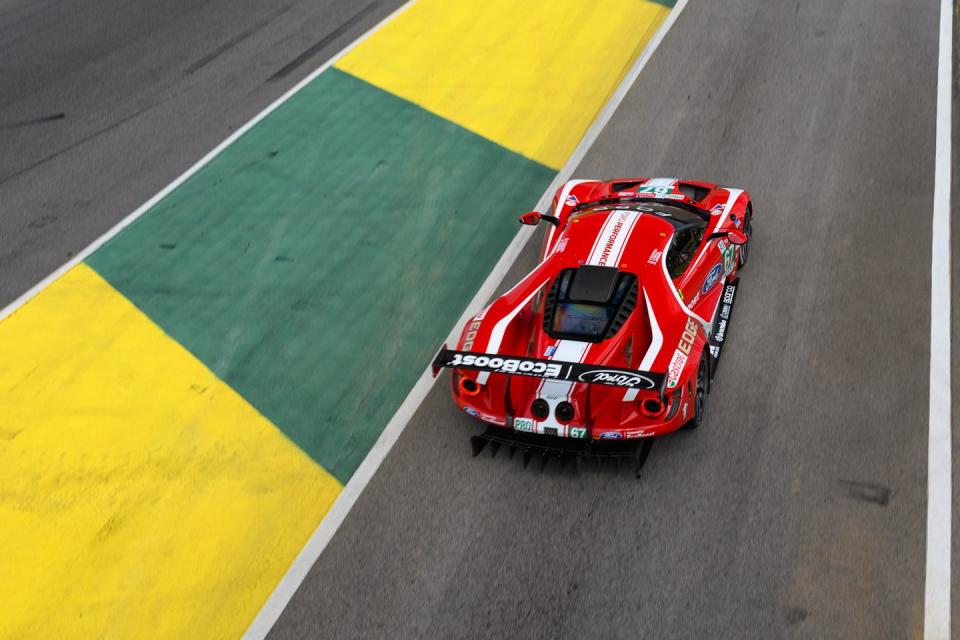
But first I have to get moving, which means imparting severe premature wear upon the 5.5-inch three-plate carbon clutch. This car does 82 mph in first gear, and the first mile per hour is the hardest. Also, of the 80 percent of its parts that this car's twin-turbo 3.5-liter V-6 shares with the F-150's engine, I have to think the flywheel isn't one of them. In fact, there's no evidence from the cockpit it even has a flywheel.
But after a couple stalls I get it out of the pits and head down to Turn 1, moving up through second and third gear just to get the feel of the shift points. Then I brake—rock hard pedal, cold brakes, turn in, and . . . the door flies open.
Like the production GT, this car has doors that open up and out, so it's a mighty strain against the harnesses to reach up to the pull strap to bring the door back down. When I manage to snag the strap, the door refuses to latch. Then the strap comes off. This is going great!
I manage to grab the nub of strap up on the door itself and hold it in a death grip as I putter around VIR to get back to the pits. The car bucks and shudders, hating the slowness, but I can't even drive semi-quickly because I can't downshift without letting go of either the door with my left hand or the steering wheel with my right. Eventually I sputter back into the pits and plead for help. Briscoe, who shut the door before I left, proclaims, "Hey, I'm a race-car driver, not a door closer." This time he slams it tight, and I'm off again.
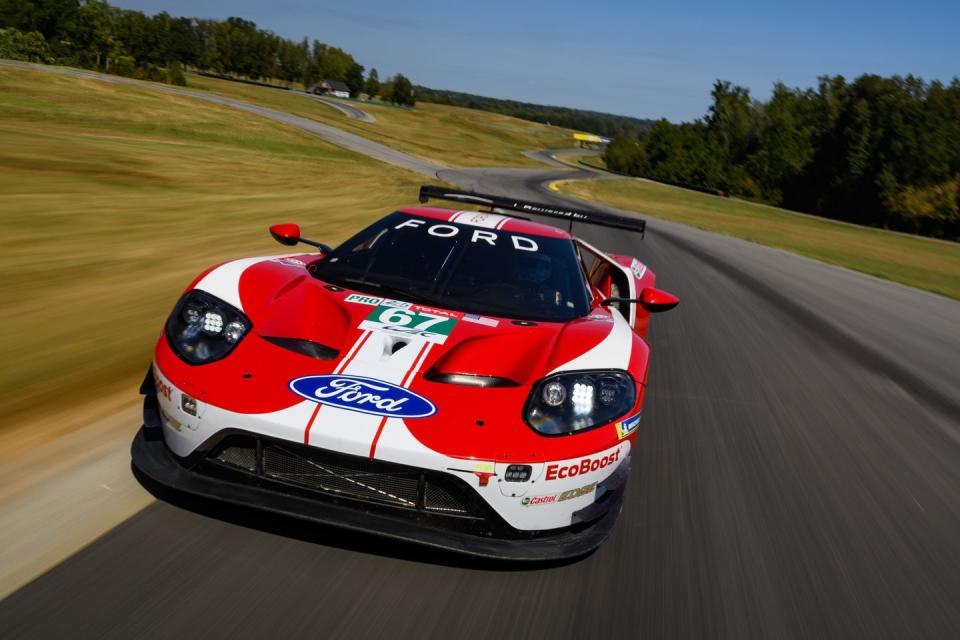
Physics Recalibrated
When you see the GTLM-spec 3.5-liter engine on a stand, it looks like the cephalothorax of a diabolical metallic arthropod, the turbos and their plumbing its antennae. At idle, it sounds cantankerous, stuttering and popping like it can't tolerate stillness. Under way, the anti-lag and traction-control systems carry on a spirited debate entitled, "All the boost or none of the boost?" The V-6 doesn't emit the smooth burr of the Mustang's V-8. It's angrier, ragged, and impatient. It's also a lot more powerful.
I spend a lap just feeling out the car's responses and trying to quell my nerves. I've been entrusted with this gazillion-dollar race car, no minders and no limits, so I don't want to screw it up. I also don't want to baby it. This is my chance to go as fast as I'll probably ever go around VIR, and I want to take advantage.
The overriding impression after one lap is that this car could use more power. It's a 500-hp momentum car. Luckily, there's a solution to that. On the back straight, I flick the boost knob over to 12, and I'm instantly crushed back in the seat. Dom hit the NOS, bro! We're running the Full Course, with the long back straight, so there's enough pavement to get into sixth gear before laying on the brakes way early. Strangely, the brakes don't feel as savage as I'd expected, yet the car still sheds speed so effortlessly that I need to get back on the throttle and then brake again before the right-hander at the end of the straight. With some of the wildest street cars, such as the McLaren Senna and Porsche 911 GT2 RS, the brakes grab with arresting-wire-on-an-aircraft-carrier violence. With the GT, it simply feels like you drove into invisible quicksand. All the speed goes away, sooner than you expected, but the process is linear and smooth and without drama. Maybe I need to stand on the pedal harder.
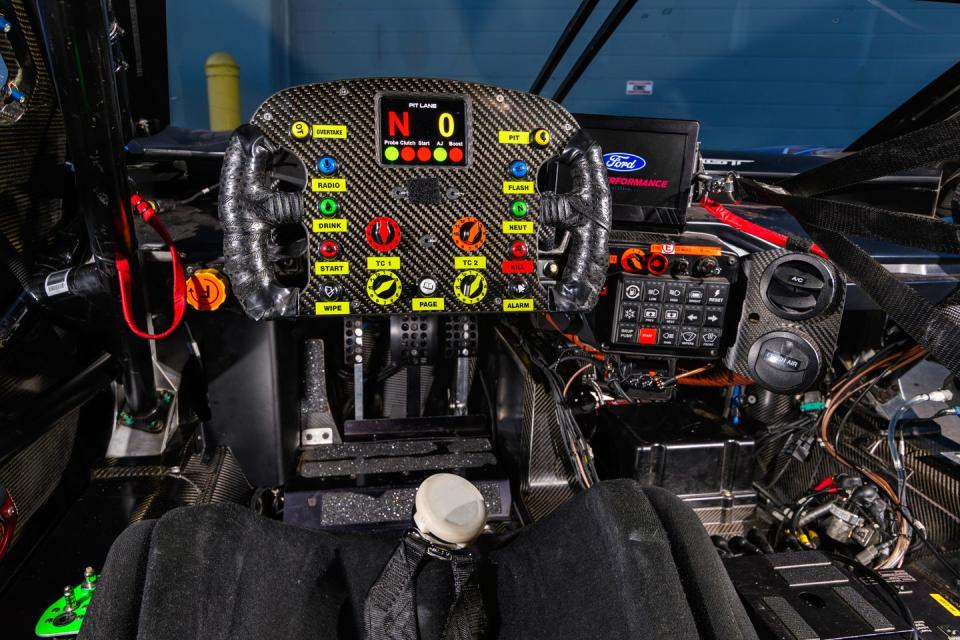
I test that theory on the front straight and brake way too early again, this time accompanied by some kind of warning siren inside the cabin. It sounds like the tone before a test of the Emergency Broadcast System. Nobody briefed me on what that means, and there's no way to ask, so I ignore it and keep driving. Turns out it's a warning for incipient lockup, since the GTLM doesn't have anti-lock brakes. I guess I'm on the pedal hard enough.
With the tires, brakes, and my blood warm, I start to pick up the pace. In Turn 1, you can effectively go full throttle about a beat or two after you're off the brakes. There's just so much grip, ever-increasing the faster you go, that it's a physical struggle to keep the pedal down. The GTLM can pull a steady 1.80 g's, according to Ford, and the stick can peak even higher, so in this right-hander, with my seat a little too far back, it's genuinely difficult to keep that long-travel accelerator down. Normally you control the throttle by flexing your calf, but with my ass lifting out of the seat I have to seemingly lock every muscle in my right leg to stay in it.
As the laps click off, I get faster. By the fifth lap, I get a good enough launch out of Oak Tree to run out of gears on the straight. Coming over the hill, I grab for an upshift, but I'm already in sixth. How fast am I going? The car's geared for 190 mph, but Ford programmed the shift lights to come on a little early, to avoid encounters with the rev limiter. Maybe 175? I don't know, which is just as well, probably. Then it's brake, brake, downshift, downshift, Emergency Broadcast System, turn in, throttle, more throttle, upshift, upshift, VIR blurring past ever quicker. Somewhere between laps four and six, the fear is shoved aside by pure euphoria. This car's limits are so high, it's like having a superpower. It's like when you turn into a bullet in Mario Kart. It is blinding, giddy fun. For all practical purposes, I can effectively drive as fast as I feel like going. Briscoe takes this car through the Climbing Esses at more than 160 mph. There's just no way I can wrap my head around performance like that. It would take more than six laps. Please, sir, may I have another?
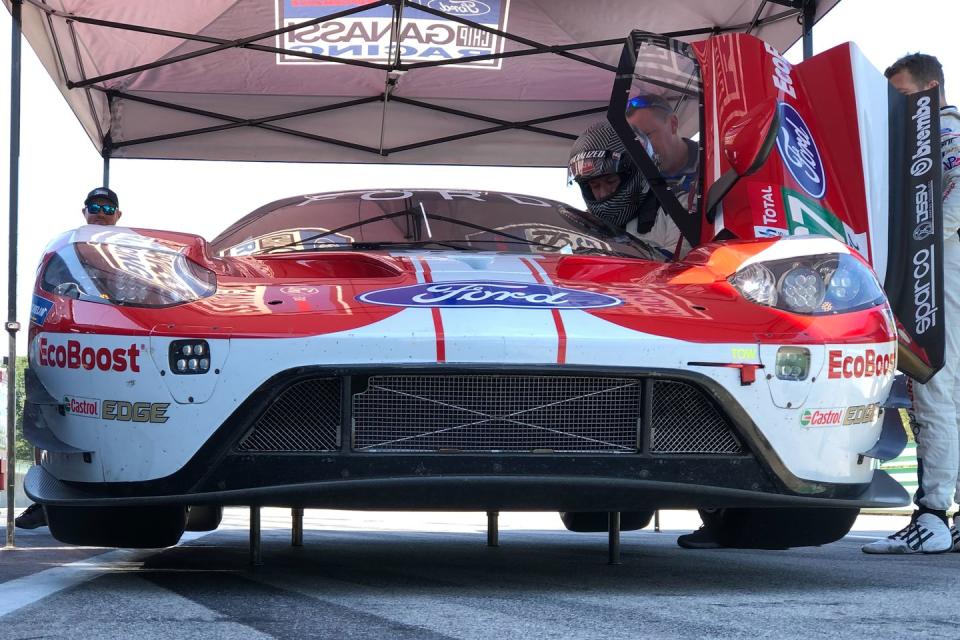
Newfound Perspective
On my last lap, my time dips into the high 1:40s. Briscoe is in the low 1:40s. The undisputed Full Course production-car record is 1:51, which was logged by Chevy Performance engineer Alex MacDonald in a 2019 Corvette ZR1. It is extremely safe to say that I would never have gone faster than that in anything that is not the 2019 Ford GT GTLM. Unless someone lets me drive a Formula 1 car or a Le Mans prototype or an extraterrestrial terra-racer extracted from alien wreckage near Groom Lake. One of those machines might be quicker, but no guarantees.
By the time I peel myself out of the seat, I'm drenched in sweat, and my watch tells me that my heartbeat is at 169 beats per minute. For me, that's a sprint at the end of a 5K. And while the physical work of driving the car is taxing, it doesn't warrant a heart rate like that. This is my pulse racing from excitement, from massive dumps of adrenaline, from the pure joy of driving a car that feels like it could go out right now and win its class at Le Mans. Because it could.
You Might Also Like

 Yahoo Autos
Yahoo Autos 